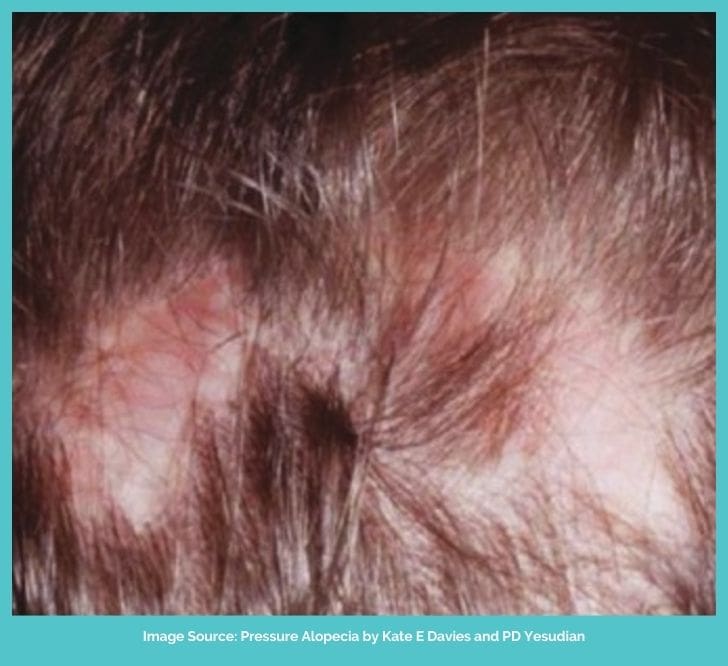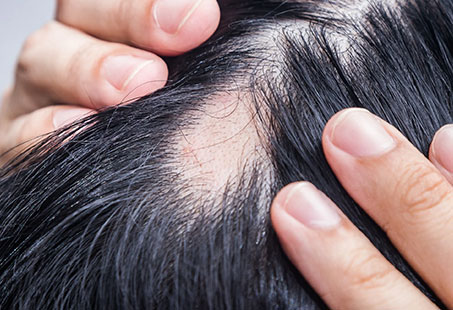As the name indicates, pressure alopecia is a type of alopecia induced by pressure. Because it usually develops after extensive surgery, it’s also known as post-operative alopecia.
While it’s a rare complication of surgeries, it’s possible to prevent it. And prevention is important because pressure alopecia can also be permanent.
In this guide, we’ll explore what pressure alopecia is and what you can do to take care of it.
What Is Pressure-Induced Alopecia?
Pressure alopecia is considered a “group of scarring and non-scarring alopecias.”
Robert R. Abel and George M. Lewis were the first ones to describe this kind of hair loss in 1960. They reported eight women who had undergone gynaecological surgery in the Trendelenburg position (supine body with feet above the head).
And all of them had developed a bald spot in the same area between 3 to 28 days after the surgery. The researchers concluded that they had lost their hair due to “pressure-induced alopecia.” They further experimented on cats to support their theory.
However, this pressure can come from other sources as well. For instance, it’s also been reported as a rare side effect of wearing orthodontic headgear.
So, it can affect both children and adults. In fact, pressure alopecia can also develop in babies because of the position in which they sleep.
According to research published in the International Journal of Trichology, the pressure duration is more significant than its intensity.
For instance, when the surgery’s longer than 4 hours, it’s a risk factor for pressure alopecia. And research shows that this risk is highest for patients who’ve been under anaesthesia for 24 hours.
Other risk factors for pressure alopecia include:
- Psychiatric disorders
- EEG electrodes
- Obesity
- Trendelenburg position
- Cervical collars
- Orthodontic headgear
- Surgical complications
- High levels of acid in the body (acidosis)
What Are The Symptoms Of Pressure Alopecia?
Before you develop pressure alopecia, you may experience the following symptoms:
- Tenderness
- Swelling
- Pain
- Redness
- Crusting
- Yellow, watery discharge
These symptoms might go away after a week.
However, in severe cases, this can lead to the death of the skin (necrosis) and result in ulceration.

You can also develop scars, which can cause cicatricial alopecia. Inflammation and follicular atrophy can also occur in the target area.
Other than that, the presence of thin, vellus hair can also be a sign of pressure alopecia. The researchers of a study published in Skin Appendage Disorders found that vellus hairs do not get much injured or deoxygenated due to their superficial location.
Therefore, this can be helpful in the diagnosis of this type of alopecia.
What Causes Pressure Alopecia?
It’s widely believed that pressure alopecia occurs due to reduced blood flow to the occipital (back) scalp tissue.
This is known as ischemia, and it happens due to the pressure on the scalp from extended periods of immobility. As the hair follicle is compressed, it’s unable to function properly.
Patients experience this while they’re unconscious under general anaesthesia while undergoing a long surgery. Most commonly, pressure alopecia has been reported after cardiac surgery.
Other than surgery, staying in the intensive care unit (ICU) for a long time can also cause the same problem.
Additionally, pressure alopecia has been reported in a patient who was wearing a headband to fix a reference frame for navigational surgery.
Published in the British Journal of Oral and Maxillofacial Surgery, the researchers concluded it was from the headband’s pressure that the patient lost their hair.
Here, it should also be noted that while most cases of pressure alopecia are limited to the back of the scalp, it can also happen on the body.
Research in Dermatologic Therapy reported pressure-induced alopecia on the abdomens of patients in prone positioning (lying on their stomach) due to COVID.
What Is The Treatment For Pressure Alopecia?
Treatment for pressure-induced alopecia depends on the severity of the problem.

Steroids and minoxidil might be prescribed if you haven’t developed any scars.
Steroids can help with inflammation, and minoxidil can dilate blood vessels to improve the supply of oxygen to the hair follicles.
Of course, the treatment also includes getting rid of the object or position that’s applying pressure to the body or scalp. Hair growth (if still possible) will resume after that.
However, if the hair loss is permanent, you can consider consulting a doctor about getting a hair transplant.
Is Pressure Alopecia Permanent?
If pressure alopecia hasn’t become cicatricial, it’s possible to reverse it and grow your hair back in about 3-4 months.
However, it’s also possible for pressure alopecia to lead to permanent hair loss. Keep in mind that in severe cases, it can even lead to necrosis of the skin. And necrosis cannot be reversed.
It can permanently damage the hair follicles, leaving scar tissue behind. Once that happens, it’s not possible to grow your back in that area.
How To Prevent Pressure Alopecia?
To prevent pressure-induced alopecia, different researchers recommend regular turning or repositioning of the head after every 30 minutes.
Other than that, it’s also recommended that patients have a soft pillow underneath their scalp. If possible, they should also get a scalp massage during the surgery to avoid pressure alopecia.
Conclusion
Pressure-induced alopecia is a rare type of hair loss. However, to those who experience it, it can be very stressful.
Unfortunately, this kind of alopecia can be permanent. The pressure from a particular position or object, exacerbated by other factors, usually leaves a bald spot on the back of the scalp.
However, if this pressure is applied to the body, it can also cause alopecia there. If you are experiencing this hair loss, it’s important to get in touch with a board-certified doctor.
Reviewed and Approved by Trichologist Yaprak Yazan
FAQ
Is pressure alopecia reversible?
Typically pressure alopecia is reversible. Patients can grow their hair back after 3-4 months.
Will hair grow back after pressure alopecia?
If your pressure alopecia is non-scarring, your hair can successfully grow back. However, hair loss will be permanent if you have developed scars.


